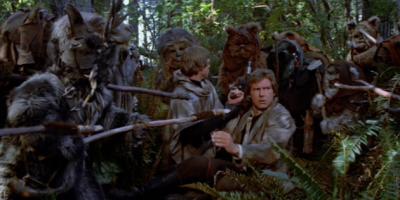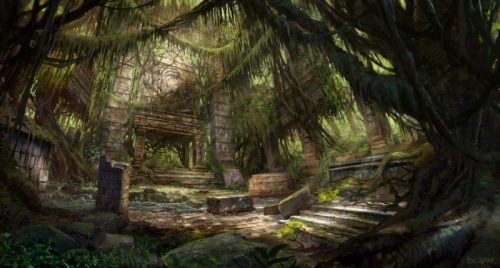Worldbuilding is all about finding a specific theme and atmosphere that pervades everything within the setting. Places, people, magic, and technologies are all means to bring that specific mood to life and make the audience feel it. But at the same time I don’t believe it’s possible to really know the right mood for the world right at the start of the worldbuilding process. You have to start with ideas that might be cool and then experiment with them to discover which work well together in a way you enjoy and then let a more specific concept take shape through these efforts. With the Ancient Lands I originally had an idea for a pretty standard fantasy world but simply with more wilderness and elves and dwarves as the primary races and humans one of several minor ones. It’s still a good idea but over the time I discovered that there are other related concepts that I would enjoy even more pursuing.
But in practice I often tend to lose track of some of the design decisions I made over the years and find myself further developing ideas that I had previously decided to drop. This requires to constantly finding the focus again, about which I wrote in my Project Forest Moon post two weeks ago. But a bit before that I wrote a few posts about antagonists and adventure templates. Which I think are pretty good, but they are for a setting about tribal warfare. Which really isn’t what I want the Ancient Lands to be. My favorite branch of Fantasy is Sword & Sorcery, which ultimately is about encounters with supernatural forces. Which my templates for antagonists really just aren’t and most of the templates for adventures aren’t either. They work, but they are generic. They don’t really do much to evoke the atmosphere that I want the Ancient Lands to have and which is meant to make it stand out from among other settings.
Another thing is that my enthusiasm for sandbox campaigning isn’t really holding up. I’ve been working on an outline for my next campaign for the last days and a sandbox where the players are meant to freely chose which of the ongoing background conflicts and events to get involved with just doesn’t get me excited as a GM. I see the potential of the concept, but I am just not feeling it. I feel much more drawn to keep running open ended adventures that encourage players to make use of support from people they had previous dealing with. A little bit like a sandbox, but one in which I chose the quest and give it to the players and then let them do with it whatever they want. Not plotting out the adventures for the players but “just giving them a little shove out the door”, as one bearded guy with a hat once said.
Now to the good part. What kinds of adventures do I think make good templates for a setting that is about encounters with the supernatural and exploring wondrous places? Here are a few ones on my new list of quests:
- Hunters report finding a ruin that was previously unknown. But being just hunters they didn’t explore it and leave that up to actual heroes. Alternatively, people have been seeing strange things from a great distance, indicating that an already known place no longer is as empty as it was believed.
- Water becomes unusable or wild animals are disappearing. This means someone has to go and find the source of this problem and deal with it, or the villages might have to be abandoned. It could be the work of a rare creature or a spirit or sorcerer who wishes the village harm.
- Supernatural forces prevent access to a valuable resources. It might be a mine or a well, a hunting ground full with animals, or an old pilgrimage site. But something unnatural has taken hold of the place and makes it impossible for people to use it. It could be something new that is disrupting the life of the local people, or something very old that has made the place inaccessible for a long time and recent events make the use of the site vital to the people.
- A returning hunter brings a curse to the village. It could be something that he did while on the hunt, a place he stumbled on, or an object he picked up. Now some kind of magical malady spreads through the village and heroes have to deal with the source and remove the effects it caused. Both can require visiting magical places or strange spirits to find a solution.
- Enemies of the clan have gained supernatural help that lets them attack the village. This supernatural influence has to be broken to save the clan from being defeated. It could be a sorcerers, a dangerous spirit, or a powerful ancient relic.
- Something is threatening the guardian spirit of the village. It has to be found and stop or the village will be unable to survive without its guardian. Often its a sorcerer who wants to steal something from the spirit or an attempt to weaken the villages under the spirit’s protection.
- Villages or traveling merchants have been disappearing. They have fallen victim to a spirit or wandered too close to a newly appeared or unearthed supernatural danger. The victims have to be saved and the danger stopped. They may have been made to serve the spirit or have otherwise been changed to be hostile against the heroes who come to investigate.
- The village’s guardian spirit demands a task has to be fulfiled. Often it will be some form of regular tribute that has been pledged by the founders of the clan in exchange for the protection of the spirit. Or one of the sacred laws has been broken and the spirit demands that the people do something to restore the supernatural order. It’s also possible that an enemy deliberately tried to disrupt the peace between the spirit and the villagers and might perhaps have stolen or destroyed an important object that needs to be recovered or replaced.

 Only on a roll of 2 on a 2d6 does a reaction roll actually indicate an immediate attack and a 3 to 5 indicates hostility with a chance that the creatures might attack. This results in only a 28% chance that a fight breaks out without the players initiating it. If you start making reaction rolls for any encounter where the reaction isn’t automatically fixed, it will change the game quite a lot. Orcs and ogres are no longer monsters but people just like bndits, mercenaries, or barbarians. Their culture might be different and unappealing to many of the PCs, but if the players handle it right they can be interacted with just like people.
Only on a roll of 2 on a 2d6 does a reaction roll actually indicate an immediate attack and a 3 to 5 indicates hostility with a chance that the creatures might attack. This results in only a 28% chance that a fight breaks out without the players initiating it. If you start making reaction rolls for any encounter where the reaction isn’t automatically fixed, it will change the game quite a lot. Orcs and ogres are no longer monsters but people just like bndits, mercenaries, or barbarians. Their culture might be different and unappealing to many of the PCs, but if the players handle it right they can be interacted with just like people.


